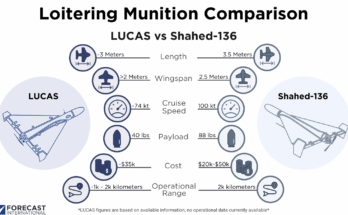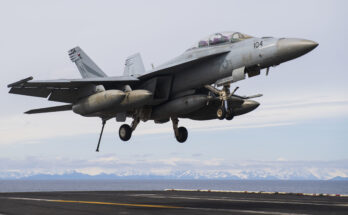
In April, the U.S. Space Force (USSF) formally accepted its latest satellite jamming technology, called Meadowlands, from L3Harris following a successful System Verification Review. Its arrival marks a wider U.S. Department of Defense (DoD) trend: a push toward open system architectures and incremental, competitively-acquired upgrades to software and hardware over the lifecycle of a given system.
Meadowlands both reflects and augurs a slow but visible change in the character of contracting by some DoD agencies. Specifically, the push for Modular Open Systems Architecture (MOSA) is a means of increasing acquisition pipelines’ flexibility and is likely to play a greater role in services like the USSF as the rate of technological change and budget uncertainties rise in tandem.
MOSA for Electronic Warfare
The 2023 U.S. National Defense Industrial Strategy, the first of its kind, explicitly invoked MOSA as a means of achieving flexible acquisition. In a nutshell, MOSA is a strategy for ensuring that a system’s components meet certain open standards that multiple vendors beyond the original can use to add, modify, or otherwise replace these components without replacing the system wholesale. Its use effectively reconceives the defense acquisition process as one that covers the entire lifecycle of a system. The USSF’s Meadowlands and other emerging counterspace systems fall into this category.
Meadowlands is an electronic warfare (EW) system: its function is to deny (jam) adversarial communications, early warnings, and propaganda. It is a ground-based, transportable, and distributed system (with units in both U.S. domestic and international sites). Meadowlands builds on and pivots from a series of upgrades performed over time on the Counter Communications System (CCS), first introduced in 2004. It at once augments capabilities in earlier versions of CCS and significantly alters the system’s architecture toward greater openness and efficiency during deployment.
A 2022 Secure World Foundation report on Global Counterspace Capabilities notes that CCS is likely capable of jamming commercial frequencies such as C- and Ku-band as well as common military frequencies like X-band, primarily targeting those communications satellites in geostationary orbit (a circular, Earth-centered orbit).
In 2019, contracting began to upgrade the existing CCS Block 10.2 (“Block” merely referring to specific upgrades). The former Harris Corporation (now merged with L3Harris) was awarded a $72 million contract for the Combat Missions System Support portfolio of ground-based EW systems belonging to the USSF’s Space and Missile Systems Center. The contract also included a directive to develop Block 10.3—Meadowlands. The contract resulted from a sole-source acquisition, with $8.1 million obligated at the time of the award. (Notably, the USSF touted the Initial Operating Capability of CCS Block 10.2 as its “first space control platform” in March 2020, indicating its significance to the service during this period.)
In October 2021, L3Harris was awarded a $120 million contract for capabilities in ground-based EW for adversarial satellite communication, early warning, and propaganda denial, with 16 fielded CCS B10.2 systems implicated for upgrades. $25.7 million was obligated at the time of award, and the contract was the result of a competitive acquisition. Then, in November 2021, L3Harris was awarded a $125 million, multi-year contract to produce EW systems—in particular CCS B10.2 systems, emphasizing the Meadowlands upgrade.
The now-upgraded and accepted Meadowlands system is conceived as a next-generation upgrade on the baseline CCS, owing in significant part to its open architecture, allowing for more regular software updates. The system also sheds some of CCS’s earlier operational footprint by reducing the necessary racks of equipment to 3 or 4 (down from 14 racks), according to a March 2021 Request for Proposals.
Meadowlands and Future Defense Acquisitions through MOSA
Meadowlands can be viewed as an effort by the USSF to move toward MOSA and more flexible acquisition. Unsurprisingly, a year out from the USSF’s release of its commercial space strategy, the service is warning industry of a pivot to either fixed-price contracts or the diffusion of programs into multiple pieces. The emphasis is on smaller and faster programs. MOSA is a means to this end.
As some commentators observe, MOSA indeed allows the DoD to move from complete and proprietary systems to “good enough” systems that can be incrementally upgraded using a broadened supplier base over their lifecycles, with the general idea of flexible contracts winding its way through the Pentagon. The U.S. Army, for example, has expressed (limited) interest in a potential shift from uniform EW equipment and gear deployed across units (flexible acquisitions of this kind allowing for more diverse prototype development), with open architectures in part enabling this flexibility.
The USSF specifically has moved to bring other systems with modular architectures from design to production, including other EW counterspace systems. In December 2024, the USSF Space Operations Command approved its first batch of new ground-based satellite communications jammers for fielding, built under the auspices of Remote Modular Terminals (RMTs). RMT has funding for 160 systems and the USSF expects to need up to 200, potentially complementing the capabilities afforded by the CCS. The Aerospace Corporation (whose R&D is federally funded) likewise developed an electric satellite interface, called Handle, for use in the Tactically Responsive Space Program (TacRS) for speedier satellite integration—erring closer towards payload-agnostic platform support.
Paralleling the shift towards efficiency with Meadowlands, the USSF Space Training and Readiness Command described RMT as a “small form-factor system” that is meant to be “fielded in large numbers at low-cost and operated remotely,” a task initially contracted out to VA-based contractor Northstrat Inc in September 2022.
Expectations should of course be managed. L3Harris notably remained the USSF’s vendor-of-choice for upgrades to CSS, potentially indicating difficulty in contract course-correction. There are, likewise, independent constraints on the pool of available contractors that comprise a supplier base. Moreover, a directive by U.S. Defense Secretary Pete Hegseth for the Pentagon to cut 8% of its budget for fund reallocation compounds the problem of moving away from expensive legacy programs that have staying power in the acquisition pipeline.
Yet, the coupling of diffuse technological progress across the services with uncertain budgets reasonably indicates that the emphasis on open architecture in Meadowlands is not an aberration. There is movement towards MOSA within the DoD generally and the USSF specifically as a means of greater acquisition flexibility. Developments like Meadowlands likely augur continued movement in this direction.
Vincent Carchidi has a background in defense and policy analysis, specializing in critical and emerging technologies. He is currently a Defense Industry Analyst with Forecast International. He also maintains a background in cognitive science, with an interest in artificial intelligence.




